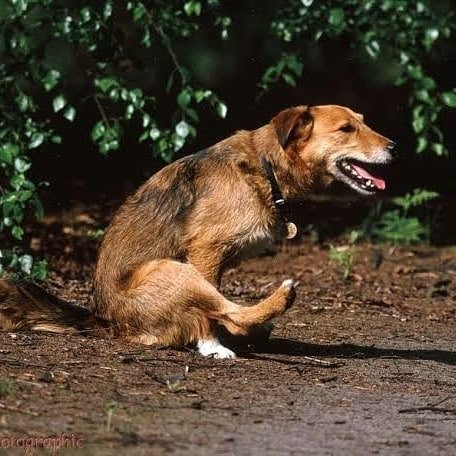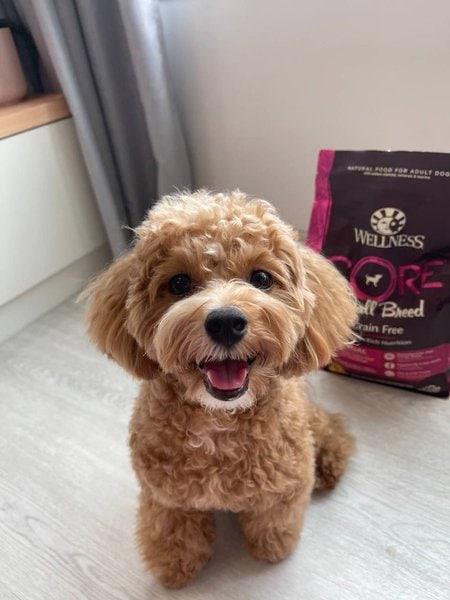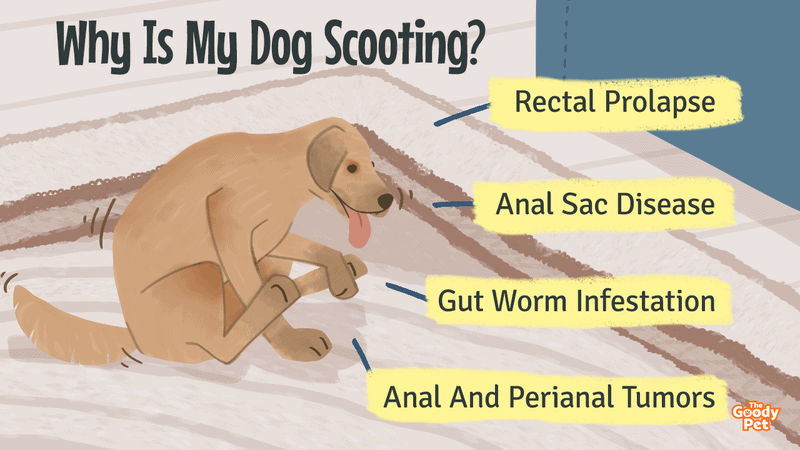Dogs dragging their butts along the floor, otherwise known as scooting, can be a puzzling behavior for many pet parents.
The most common cause of scooting is anal gland irritation. Anal glands are small sacs located on either side of your dog’s anus. They’re filled with a foul-smelling liquid used to mark their territory. When these glands get full or irritated, your dog may try to relieve the pressure by scooting its bottom along the floor.
In this article, we’ll look at some of the most common reasons dogs scoot and what you can do to help them feel better.
Why Is My Dog Scooting?
As a dog owner, you may notice your dog dragging their body across the floor or even over grass outdoors.
This behavior is known as scooting and is done for one main reason, which is scoot for one main reason, and this is to relieve irritation in the anal glands.
They may also do this as a way to mark their territory, although this is very rare.
The abrasion gives them a sense of much-needed relief. So what causes the irritation in the first place? Here are the four main culprits.
Rectal Prolapse
This is where a segment of the rectum protrudes into the anal opening or even out of the body. It is a serious condition that requires urgent veterinary intervention.
Gut Worm Infestation
Your dog may also be scooting their bottom on the floor, especially after pooping due to digestive system parasites.
Some of the most commonly implicated in this case are whipworms, roundworms, and hookworms.
Deworming is one of the best solutions in this case which we will look closer at in a bit.
Anal Sac Disease
Dog anal sac disease is a condition where inflammation of ducts causes the dog’s anal glands to fill. If the secretions are not released, they may become impacted or even infected. Fortunately, this is a problem you can solve on your own by simply expressing the glands. We will touch on that in the next section.
Anal And Perianal Tumors
Another reason why your dog is dragging their back legs and butt on the floor can be due to anal and perianal tumors.
These could be in the anal glands themselves or in the tissues around them, resulting in blockage of ducts and accumulation of sections. This will definitely need veterinary attention.
Can You Express Your Dog’s Glands At Home?
Expressing anal glands is one of the best ways to relieve the irritation that your dog is inevitably experiencing.
You could have this done professionally by a vet or even by dog groomers.
How much you will pay for dog anal gland expression will depend on where you go to have it done.
Dog anal gland expressing could be as low as $8 to $15 or as high as $200.
You could also do it yourself at the convenience of your home.
In this case, plan to express your dog’s anal glands every six months to a year.
You may have to do this on a more regular basis if your dog develops more blockage and irritation. In this case, you will notice a foul-smelling discharge from your dog’s butt, which is the best sign your dog’s anal glands need to be expressed.
There are two ways to squeeze your dog’s glands:
External Anal Gland Expression Method
This method involves placing your forefinger and thumb about an inch width on either side of the anus and squeezing. This is mainly effective with minor buildup.
Internal Expression Method
Here, insert the forefinger into the anus feeling for the inflamed gland. Then use your thumb to press against the swelling until fluid comes out. Continue until there is nothing left upon squeezing. This is ideal for dogs with serious buildup and early stages of impaction.
Here is a video for a clear demonstration of the processes.
How Else Can I Get My Dog To Stop Scooting?
Expressing the anal glands works really well with issues like anal sac disease. However, you may notice that your dog is still scooting even after its anal glands have been expressed. This is because expressing is not always the solution in some cases.
To help you out, here are a few other things you could do to stop your dog from scooting.

Clear Any Grime Buildup Around The Area
A dirty butt can be the reason why none of your expressing efforts are paying off.
If you do not clean up properly especially after expressing, remnants of the secretions, as well as dirt and grime, can build up in the area.
This results in blockage of the ducts and leaves you right where you started. It is therefore wise to invest in special anal gland wipes to keep the area clean and airy.
Let Mild Injuries Heal On Their Own
You should not put Vaseline on your dog’s bum or any other jellies or ointments if the irritation is a result of mild injuries. This will only cause further blockage and result in the recurrence of the scooting issue.
Instead, just let them heal on their own while monitoring for complications like infections.
Take The Dog To The Vet
A lot of the causes of scooting are serious medical conditions that require urgent professional attention. These include tumors, prolapse, anal abscesses, and many others. Therefore, if expression and proper hygiene are not working, you should call your vet and book a visit as soon as possible.
How To Prevent Anal Sac Problems In Dogs?
Clearly, there is a lot you can do to ease your dog’s discomfort when it comes to anal sac issues. However, there is nothing better than working on proper preventative measures. It goes without saying that these are better for the dog’s health and well-being, as well as your own peace of mind. So, without further ado, here is how you can prevent anal sack problems in your dog.
Healthy Diet

Diet plays a major role when it comes to the occurrence of irritated anal glands. One of its biggest contributions is food intolerance. Although rare, food allergies have been linked to inflammation and blockage of anal glands and ducts.
This happens when the dog’s bottom becomes itchy as a result of the allergic reaction. In the process of scooting for relief, they may cause perianal injuries which in turn result in anal gland blockage.
Here, we recommend Ollie for a healthier diet, especially for dogs with food sensitivity. The best part is that the meal plans are customized to fit your pooch’s needs.
High Fiber Food
Constipation could be another reason why your dog’s anal glands are acting up. One way this happens is through anal injuries as the dog struggles to pass the hard stools. A high-fiber diet makes life a whole lot easier for them by normalizing the consistency of the stool and promoting peristalsis.
You could give them fiber-rich foods like pumpkins and brown rice. You could also go with dog foods with special high-fiber recipes.
Wellness Core High Fiber Dog Food is definitely the best in this case. The best part is the presence of probiotics and prebiotics for improved overall gut health.
Fish Oil
Fish oil also has a lot to offer when it comes to prevention. It works by reducing the amount of inflammation in the lining of the anus and the skin around it.
This comes in handy whether the blocked glands are due to food allergies or injuries around the area.
For this, we recommend the Zesty Paws Pure Wild Alaskan Salmon Fish Oil. Its liquid formula makes it very convenient to administer, and it is extremely rich in omega-3 fatty acids.
How Can I Tell If My Dog Has Worms? How Do You Get Rid Of Worms In Dogs?
Considering how big of a role digestive system worms play, deworming is one of the best tools in your arsenal when it comes to dealing with scooting as a result of irritated anal glands.
There are many ways to tell whether or not your dog has worms and if they are the cause of the scooting.
One of the best ways is to observe the dog’s poop for things like whole worms, worm segments, or even their eggs. You may also notice blood in the stool.
Another telltale sign that it can be a worm infestation is weight loss despite having a good appetite.
With time, even the appetite will reduce. Finally, if they have frequent periods of constipation, it could be that the dog has a heavy infestation with obstruction.
Deworming is often very effective when it comes to getting rid of these problematic parasites.
It is recommended that you get your dog dewormed every 3 months.
This counts whether your dog is a full-time indoor pooch or they get to go in and out as they please.
In addition to keeping to the recommended schedule, you should also ensure that you use the right dewormer. Panacur C Canine Dewormer, in this case, is our top pick.
The fenbendazole granules can be given with both dry and wet food.
Just follow the instructions and make sure to consult your vet for confirmation of appropriate doses for your dog.
Related Questions
Should Groomers Express Glands? Anyone can express dog anal glands, including groomers. In fact, most of them do it routinely as a part of the complete grooming process. However, it is important to keep them informed about the dog’s last expression to avoid overdoing it and causing irritation when everything was already fine before.
What Dog Breeds Need Their Glands Expressed? Anal gland issues cut across breeds and depend on more factors than simply the type of dog. However, some breeds are more prone to these issues than others. Small dog breeds, in particular, need their glands expressed as much as once every month. The most affected are Toy Poodles, Cocker Spaniels, Lhasa Apso dogs, and Beagles.
Can Dogs Express Their Own Glands By Licking? A dog cannot effectively express their own glands by licking. However, you will notice that a dog that is expressing scooting behavior also licks its butt a lot. This is done to relieve any pain or itchiness that may be associated with the backed-up anal glands and not necessarily to express them.





